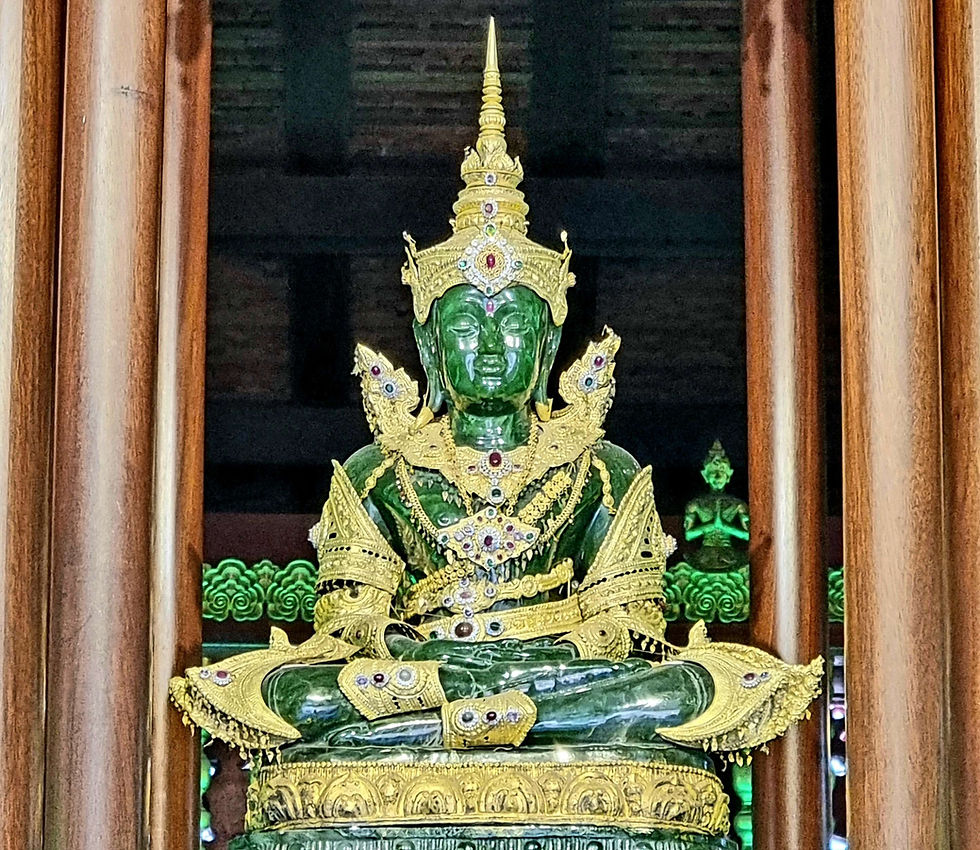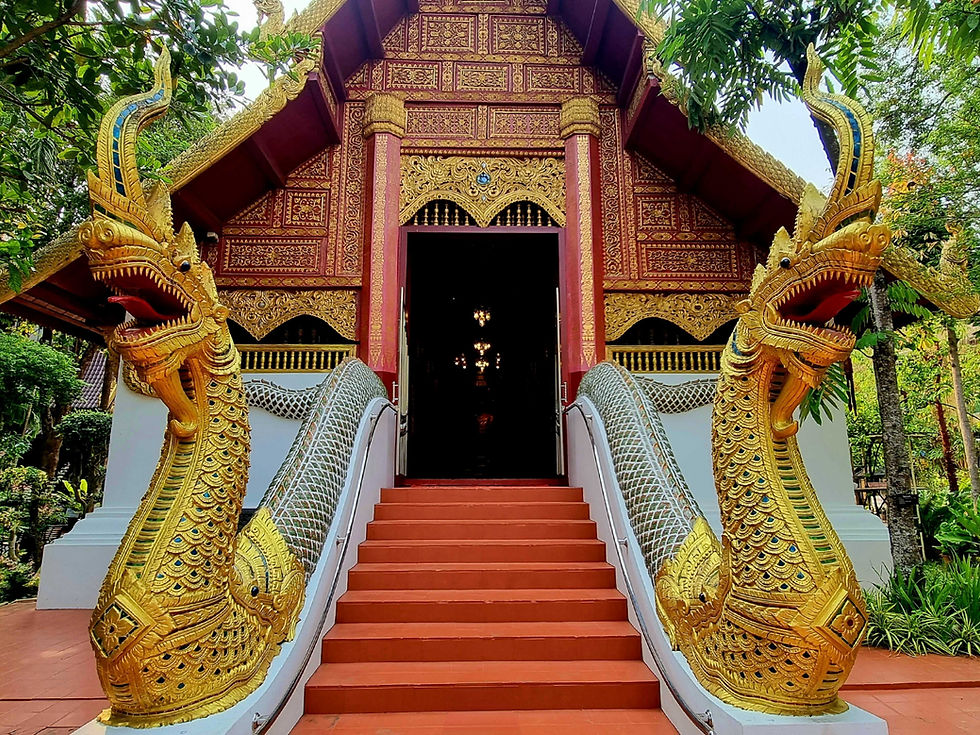Wat Phra Kaew Chiang Rai and The Sacred Storm
- Shannon
- Sep 24
- 4 min read
The Sacred Cradle of the Emerald Buddha
Tucked away in the northern Thai city of Chiang Rai, Wat Phra Kaew is a temple steeped in legend, royal heritage and spiritual significance. Once called Wat Pa Yeah or the "Bamboo Forest Temple," it was renamed after its association with the famed Emerald Buddha, now enshrined in Bangkok. Established as a royal temple during the Lanna Kingdom in the late 14th century, it stands as one of Chiang Rai’s oldest religious sites still in operation today. Unlike many temples that serve purely as tourist destinations, Wat Phra Kaew remains a fully functioning monastery, home to a resident community of monks who carry out daily rituals, alms rounds, meditation sessions and teachings in the traditional Theravāda style.

The temple rose to national fame in 1434 when lightning struck its ancient chedi, cracking open the structure and revealing a stucco covered Buddha image inside. Initially dismissed as unremarkable, the statue was later found to conceal a rare green icon beneath its outer layer. When a piece of stucco chipped off the nose, revealing a deep green surface, closer inspection confirmed it was carved from semi precious jade, what we now call the Emerald Buddha. Historians believe the statue had been deliberately coated in plaster to hide its true value from potential invaders during a period of political instability.

Wat Phra Kaew Chiang Rai remains deeply tied to the Sacred Storm, a symbol of the Emerald Buddha’s powerful beginning
King Samfangkaen of the Lanna Kingdom recognised the importance of the Emerald Buddha and ordered it to be transported to Chiang Mai, then the capital. A rare white elephant was chosen to carry the statue, a symbol of royal power and divine favour. However, in a curious twist of fate, the elephant refused to head toward Chiang Mai, diverting to Lampang three times despite efforts to redirect it. This behaviour was interpreted as a divine sign, suggesting the Emerald Buddha was meant to stay in Lampang. The king conceded, allowing the sacred image to remain there for over three decades, reinforcing the idea that spiritual forces were actively guiding its path.
Over the next 300 years, the Emerald Buddha continued its dramatic journey across Southeast Asia. From Lampang, it passed through various cities including Chiang Mai, Luang Prabang and Vientiane, each time becoming a prize sought after by rulers who believed its presence would secure wealth, stability and religious merit. Entire military campaigns were launched to obtain it, not simply for its craftsmanship or monetary value but because the statue had become a symbolic embodiment of divine legitimacy and political sovereignty.

The final chapter of the Emerald Buddha’s journey came in 1782, when King Rama I founded the Chakri dynasty and declared Bangkok the new capital of Siam. Recognising the statue’s unparalleled importance, he constructed the Wat Phra Kaew temple within the Grand Palace complex specifically to house the Emerald Buddha. Three years later, in 1785, it was enshrined in its new ceremonial home, where it remains under strict royal care. The icon is changed into seasonal robes three times a year by the king himself, a ritual believed to bring good fortune and mark the shifting of Thailand's climate.
Though the original Emerald Buddha now resides in Bangkok, Chiang Rai’s Wat Phra Kaew continues to honor its sacred legacy. Today, visitors can see a faithful green jade replica of the statue in the main viharn, surrounded by golden naga balustrades and traditional Lanna architectural features. The temple grounds also include a museum housing ancient scriptures, Buddhist artifacts and a history of the Emerald Buddha’s odyssey. For many, this modest temple is more than a historic footnote, it is the very place where divine intervention once split stone and revealed a hidden jewel that would shape centuries of Thai spiritual and political identity.
🗺️ Location
19 Mu 1 Trairat Roadd, Tambon Wiang, Amphoe Mueang Chiang Rai, Chang Wat Chiang Rai, Thailand
🚆 How to get there
Wat Phra Kaew sits just 850 metres northwest of the Chiang Rai Clock Tower, an easy 15 minute walk that cuts through the city’s backstreets and quieter alleys. If you’d rather skip the heat or save time, a metered taxi will get you there in a few minutes for around 60 baht.
⭐ Attraction Info
The temple grounds are open daily between 7am - 6pm, offering plenty of time to explore the peaceful complex and observe monastic life. The onsite Phra Kaew Museum, open from 9am to 5pm, was built in 2006 and showcases a curated collection of religious artefacts, priceless sculptures, and ancient Thai art from the Lanna era (1296–1558). It provides valuable context for understanding the region’s spiritual heritage and the temple’s historic significance and is definitely worth a look. Entry to both the temple and museum is free of charge, though donations are welcomed and go directly toward the maintenance of the grounds and support of the resident monks. Visitors are asked to dress respectfully, this means covering shoulders and knees, regardless of the weather. As with most sacred sites in Thailand, shoes must be removed before entering any temple buildings. Take care not to walk directly in front of people who are praying or meditating and keep voices low to maintain the serenity of the space.
วัดพระแก้ว เชียงราย

Thanks for reading about Wat Phra Kaew Chiang Rai and The Sacred Storm. Check out more destinations here!


































